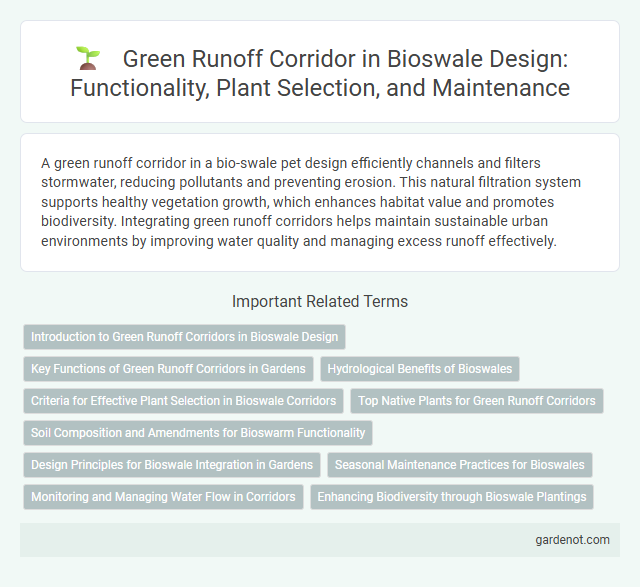A green runoff corridor in a bio-swale pet design efficiently channels and filters stormwater, reducing pollutants and preventing erosion. This natural filtration system supports healthy vegetation growth, which enhances habitat value and promotes biodiversity. Integrating green runoff corridors helps maintain sustainable urban environments by improving water quality and managing excess runoff effectively.
Introduction to Green Runoff Corridors in Bioswale Design
Green runoff corridors are essential components in bioswale design, directing stormwater through vegetated pathways to enhance natural infiltration and pollutant filtration. These corridors reduce surface runoff, mitigate flooding risks, and improve water quality by leveraging native plants and engineered soil layers. Integrating green runoff corridors within bioswales supports sustainable urban drainage by promoting groundwater recharge and providing habitat for local biodiversity.
Key Functions of Green Runoff Corridors in Gardens
Green runoff corridors in gardens function as natural filtration systems, capturing and absorbing stormwater to reduce pollutants before they reach water bodies. These corridors enhance soil infiltration, promote groundwater recharge, and mitigate flooding by temporarily storing excess runoff. By supporting native vegetation, green runoff corridors also improve biodiversity and contribute to the overall health of urban ecosystems.
Hydrological Benefits of Bioswales
Bioswales serve as green runoff corridors that effectively manage stormwater by facilitating infiltration and reducing surface runoff volume. Their design promotes sediment removal and pollutant filtration, enhancing water quality before it reaches natural water bodies. By increasing groundwater recharge and decreasing urban flooding risks, bioswales contribute significant hydrological benefits within sustainable landscape practices.
Criteria for Effective Plant Selection in Bioswale Corridors
Effective plant selection in bioswale corridors prioritizes native species with deep root systems to enhance soil infiltration and stabilize runoff. Plants must tolerate periodic flooding and drought to maintain performance under variable hydrological conditions. Selecting diverse, pollutant-absorbing species supports optimal nutrient uptake and maximizes water quality improvement within green runoff corridors.
Top Native Plants for Green Runoff Corridors
Top native plants for green runoff corridors include Carex stricta (tussock sedge), Juncus effusus (soft rush), and Asclepias incarnata (swamp milkweed), valued for their high water absorption and soil stabilization properties. These species enhance bio-swale efficiency by filtering pollutants and supporting local biodiversity while requiring minimal maintenance. Incorporating such plants improves stormwater management and promotes sustainable urban landscaping.
Soil Composition and Amendments for Bioswarm Functionality
Optimal soil composition for bio-swale green runoff corridors includes a well-balanced mix of sandy loam, organic matter, and clay to enhance infiltration and pollutant filtration. Soil amendments such as compost, biochar, and mycorrhizal fungi improve soil structure, nutrient retention, and microbial activity critical for bioswale functionality. These components collectively support stormwater management by promoting water absorption, reducing runoff velocity, and facilitating contaminant breakdown.
Design Principles for Bioswale Integration in Gardens
Bioswale design principles prioritize efficient stormwater capture and natural filtration using native plants with deep root systems to enhance soil permeability. Strategic contouring and graded slopes guide runoff through vegetated channels, maximizing pollutant removal and groundwater recharge. Incorporating permeable materials and ensuring proper maintenance are essential for sustainable bioswale integration in garden landscapes.
Seasonal Maintenance Practices for Bioswales
Seasonal maintenance practices for bioswales in green runoff corridors include regular inspection and removal of accumulated debris, sediment, and invasive vegetation to ensure optimal water infiltration and pollutant filtration. During the growing season, targeted pruning and replanting native vegetation enhance erosion control and biodiversity, while fall and winter activities involve clearing fallen leaves and managing water flow to prevent clogging. Implementing these practices preserves the bioswale's hydraulic efficiency and supports stormwater management goals year-round.
Monitoring and Managing Water Flow in Corridors
Green runoff corridors in bio-swales employ advanced monitoring technologies such as flow sensors and water quality analyzers to track water volume, speed, and pollutant levels in real time. Data collected enables precise management of water flow, ensuring optimal infiltration, sediment settling, and pollutant removal while preventing overflow and erosion. Regular monitoring supports adaptive maintenance strategies that optimize ecological performance and enhance stormwater management efficiency.
Enhancing Biodiversity through Bioswale Plantings
Bioswale plantings in green runoff corridors significantly enhance biodiversity by providing diverse native vegetation that supports local wildlife habitats and pollinators. These plantings improve water quality through natural filtration while creating ecological corridors that connect fragmented habitats. Incorporating a variety of native grasses, shrubs, and aquatic plants fosters resilient ecosystems and promotes sustainable urban water management.
Green runoff corridor Infographic

 gardenot.com
gardenot.com